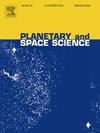利用超宽带探地雷达表征地下非均质性:应用于罗莎琳德·富兰克林ExoMars任务的探地雷达WISDOM
IF 1.7
4区 物理与天体物理
Q3 ASTRONOMY & ASTROPHYSICS
引用次数: 0
摘要
超宽带探地雷达(GPR)对大范围的散射体尺寸非常敏感。考虑到地下的分形非均质性,我们提出了一种提取其典型尺寸L的方法。用这种方法确定L不需要先验地了解所研究地下介电常数值的统计分布。该方法基于对后向散射信号的频率/波长子带分析。它适用于罗莎琳德·富兰克林ExoMars任务(ESA)漫游车上的探地雷达WISDOM,但可以应用于任何超宽带探地雷达。数值模拟结果表明,在波长λ=(5.3±0.2)L处后向散射达到最大。我们证明,即使存在适度的电损耗,也可以识别出这个最大值,因此L与月球或火星上的预期条件相一致。假设平均介电常数为5,只要介电常数在0.9-4.2 cm范围内,WISDOM (0.5 - 3ghz)数据产品就可以估算出L。在受控环境下获取的实验WISDOM数据上验证了L的检索方法。本文章由计算机程序翻译,如有差异,请以英文原文为准。
Characterizing heterogeneities in the subsurface with an ultra-wideband GPR: Application to WISDOM, the GPR of the Rosalind Franklin ExoMars mission
Ultra-wideband Ground Penetrating Radars (GPR) are sensitive to a large range of scatterer sizes. Considering fractal heterogeneities in the subsurface, we propose a method to retrieve their typical size L. The determination of L with this method does not require a priori knowledge of the statistical distribution of permittivity values in the investigated subsurface. The method relies on the analysis of the backscattered signal by frequency/wavelength sub-bands. It is adapted to WISDOM, the GPR onboard the rover of the Rosalind Franklin ExoMars mission (ESA), but can be applied to any ultra-wideband GPR. Based on numerical simulations, a maximum in volume backscattering is reached at the wavelength (in the subsurface) . We demonstrate that this maximum, and therefore L, can be identified even in presence of moderate electrical losses, compatible with conditions expected on the Moon or Mars. Assuming an average permittivity of 5, WISDOM (0.5–3 GHz) data products could be used to estimate L as long as it is in the range 0.9–4.2 cm. The retrieval method for L is validated on experimental WISDOM data acquired in a controlled environment.
求助全文
通过发布文献求助,成功后即可免费获取论文全文。
去求助
来源期刊

Planetary and Space Science
地学天文-天文与天体物理
CiteScore
5.40
自引率
4.20%
发文量
126
审稿时长
15 weeks
期刊介绍:
Planetary and Space Science publishes original articles as well as short communications (letters). Ground-based and space-borne instrumentation and laboratory simulation of solar system processes are included. The following fields of planetary and solar system research are covered:
• Celestial mechanics, including dynamical evolution of the solar system, gravitational captures and resonances, relativistic effects, tracking and dynamics
• Cosmochemistry and origin, including all aspects of the formation and initial physical and chemical evolution of the solar system
• Terrestrial planets and satellites, including the physics of the interiors, geology and morphology of the surfaces, tectonics, mineralogy and dating
• Outer planets and satellites, including formation and evolution, remote sensing at all wavelengths and in situ measurements
• Planetary atmospheres, including formation and evolution, circulation and meteorology, boundary layers, remote sensing and laboratory simulation
• Planetary magnetospheres and ionospheres, including origin of magnetic fields, magnetospheric plasma and radiation belts, and their interaction with the sun, the solar wind and satellites
• Small bodies, dust and rings, including asteroids, comets and zodiacal light and their interaction with the solar radiation and the solar wind
• Exobiology, including origin of life, detection of planetary ecosystems and pre-biological phenomena in the solar system and laboratory simulations
• Extrasolar systems, including the detection and/or the detectability of exoplanets and planetary systems, their formation and evolution, the physical and chemical properties of the exoplanets
• History of planetary and space research
 求助内容:
求助内容: 应助结果提醒方式:
应助结果提醒方式:


